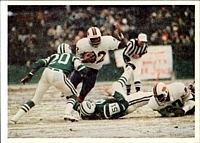Start date 1973 | ||
 | ||
Duration September 16 – December 16, 1973 Similar 1974 NFL season, 1969 NFL season, 1970 NFL season, 1982 NFL season, 1984 NFL season | ||
The 1973 NFL season was the 54th regular season of the National Football League. The season featured O.J. Simpson becoming the first player to rush for 2,000 yards in one season. Buffalo moved their home games into Rich Stadium. After playing their first two home games at Yankee Stadium, the New York Giants played the rest of their home games at the Yale Bowl. The season ended with Super Bowl VIII when the Miami Dolphins repeated as league champions by defeating the Minnesota Vikings 24-7 at the Rice Stadium in Houston Texas. The Pro Bowl took place on January 20,1974 at Arrowhead Stadium in Kansas City, Missouri. The AFC beat the NFC 15-13.
Contents
Jersey numbering system
Television Blackout rules
Up until the 1972 season, all NFL games (including championship games and Super Bowls) were blacked-out on television in each team's home city. In 1973, the league changed their policy to black out games in the team's home city only if tickets to the game had not sold out. This expanded the league's television presence in teams' home cities on gameday.
The policy was put into effect when, in 1972, the Washington Redskins made the playoffs for only the second time in 27 seasons. Because all home games were blacked-out, politicians — including devout football fan President Richard Nixon — were not able to watch their home team win. NFL commissioner Pete Rozelle refused to lift the blackout, despite a plea from United States Attorney General Richard Kleindienst. Kleindienst was to suggest that the United States Congress re-evaluate the NFL's antitrust exemption. Rozelle agreed to lift the blackout for Super Bowl VII on an "experimental basis." But Congress intervened before the 1973 season anyway, passing Public Law 93-107, which eliminated the blackout of games in the home market so long as the game was sold out by 72 hours before game time.
Division races
Starting in 1970, and until 2002, there were three divisions (Eastern, Central and Western) in each conference. The winners of each division, and a fourth "wild card" team based on the best non-division winner, qualified for the playoffs. The tiebreaker rules were changed to start with head-to-head competition, followed by division records, common opponents records, and conference play.
National Football Conference
Final standings
W = Wins, L = Losses, T = Ties, PCT= Winning Percentage, PF= Points For, PA = Points Against
x – clinched wild card berth, y – clinched division title
Tiebreakers
Coaching Changes
After 11 years as head coach of the New York Jets, Weeb Ewbank decided to retire.
